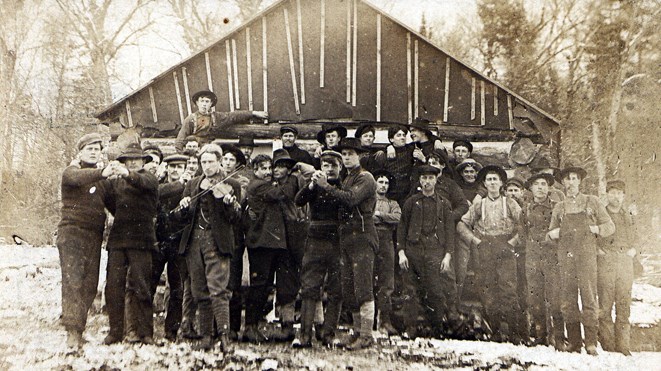Nilgiri Pearson for Sudbury.com
Ours is a city of immigrants. The irony is that even for old-stock Sudburians, digging down to demonstrate how deep your roots in the region go only brings you closer to someone from somewhere else.
Every one of the railwaymen who spent the spring and summer of 1883 cutting lines for the CPR across the Nickel Basin's rocky outcrops, and on through the dense Algoma brush that covered them, were newcomers. It was a bit like Noah's Ark in fact. Among these men were representatives of Sudbury's now-iconic ethnic communities – a Finn, Pole, Ukrainian, Croatian, Italian – as well as Irish and Englishmen.
They founded communities within a community and over the next half-century welcomed an intermittent but unceasing influx of immigrants, many fleeing political instability and economic privation in Europe – refugees, in other words. At one point in 1910, fourteen neighbours on two streets in Copper Cliff – Elizabeth, and Rink Street – provided accommodation for nearly 170 fellow Ukrainians.
For native-born Sudburians, they were “the other.”
At one time or another the Protestant majority were suspicious of the Catholic minority; western Europeans of poor eastern Europeans; those with kinsmen on one side of the trenches in Flanders, Caporetto or Galicia, of those on the other; those with origins in democratic countries of those hailing from Communist or Fascist states. And in polyglot Sudbury, there was always the language-barrier.
These suspicions should not be overstated. Nor ignored. Sudbury's history is a comparatively harmonious and inclusive one. But in times of stress or conflict, ugly divisions did emerge.
In 1914 Canada declared war on the Austro-Hungarian Empire, the former home of many Croatians, Poles and Ukrainians. For two years these “enemy aliens” lived in constant fear of internment until, in 1916, the government belatedly determined they posed no threat.
Today Finland is known as an advanced, peaceable Scandinavian welfare-state. Few remember that following independence in early-1918 Finland devolved into a brutal, fratricidal civil-war. In five months of fighting 40,000 people were killed and the country lay in ruins. Many others fled. The United States imposed a quota on these “economic migrants,” so many elected to join relatives in Canada – Sudbury in particular – instead.
When some Finns – many of whom are now regarded as heroes of the labour movement – began agitating for safer conditions in Sudbury's mines, they suffered employment discrimination and were labeled “communists.”
In 1945 Stalin formally annexed eastern Poland, Moldova and parts of Slovakia and Romania. Many Poles and Ukrainians who had experienced – and actively resisted – Soviet tyranny faced forcible repatriation to the U.S.S.R. from refugee camps in Europe. The government of Mackenzie King admitted 35,000 of these into Canada, but only in the face of fierce opposition by those who were less concerned that “they” would invariably be interned in the Gulags, than that “we” could (possibly) be infiltrated by any Communists among them. Several thousand ultimately settled in Sudbury.
In the 1930s, Florence Howey, reminiscing about Sudbury's first harsh winter 50 years earlier wrote “... [it] proved to be... very cold... with great quantities of snow and blustery storms. There were many Italians working on the road, many of them just out from their sunny Italy.” One wonders what Howey – who died in 1936 – would have thought if she'd known that the descendants of these very same, indefatigable trailblazers – literally - would be labeled “enemy aliens,” a mere four years later, be banned from owning firearms, and live in fear of arrest, following Mussollini's declaration of war on the Allies in 1940.
The list of peoples – immigrants and refugees alike – who survived and thrived in the mines, or downtown, or amidst the wilderness of the Sudbury region, sometimes in the face of suspicion and xenophobia that was no less vehement for being intermittent, continues: Hungarians (mid-1950s); “Boat People” (1980s); Indians, Africans and people from the Caribbean (1990s-2000s). Today it is Syrians.
“They” speak a different language. “They” practice a different religion. “They” look different. But then again “we” all have, once upon a time. Then as now pundits - from Canada and around the world - have dipped into each of these pots of difference and painted an entire people with broad, ideological brush-strokes which our neighbours now wear like an invisible ink. It’s transparent to many; to a few it is as red to a bull.
Hopefully you form your own opinion, as Sudburians are wont to do. In the final calculus of your conclusion, imagine living in a Sudbury that doesn’t feature names such as “Dozzi” or “Toppazzini”, “Erola” or “Maki”, “Trebek”, “Christakos” or “Esmie.”
Or think of Sudbury's First-Nation's residents. Our city is young enough that some of our seniors can still remember childhood conversations with the Elders of Atikameksheng Anishnawbek or Wahnapitaeping who could themselves recall a time before the arrival of Europeans.
How would “they” have labelled “us”?
Nilgiri Pearson is a life-long Sudburian. He studied history at Laurentian University and Law at Trinity College Dublin. He is currently finishing an MA in Humanitarian Action and is the co-ordinator for Lifeline Sudbury, an umbrella group working with private sponsors of refugees in Sudbury.
